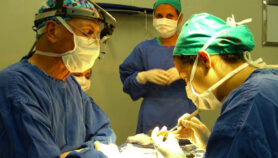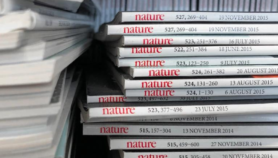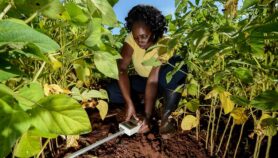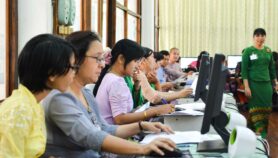By: Lisbeth Fog
Send to a friend
The details you provide on this page will not be used to send unsolicited email, and will not be sold to a 3rd party. See privacy policy.
Science journalism in some Latin American countries: what’s the deal?
Lisbeth Fog
I wish I had enough knowledge to talk about science and the media in all developing countries. But it would be very ambitious for me to cover countries on continents other than Latin America. Being more realistic, if still a bit pretentious, I will try to give you an overview of science journalism in some countries of my region. Still, it is a huge issue. Using information provided by colleagues from Argentina, Brazil, Chile, Ecuador and Mexico, and of course my Colombia, as well as some examples taken from newspapers in these countries, I will try to give you an overview and show you how we deal with science news.
Why write science stories?
In most countries of Latin America, science journalists write their articles mainly for three reasons: To inform, to educate, and to entertain.
To inform, because that’s what we are in the mass media for: to tell the news, to inform about new products, new knowledge, new tendencies and ways of thinking, new and different facts. That is what news is all about. We share this goal with our colleagues who cover other sources: we are always in search of those activities that allow evolution to happen, evolution in controversies, in different approaches to life, in social development.
To educate, because we still have an important percentage of non-literate people, which means not only that they cannot read or write, but also they are unable to understand science stories. Nobel Prize winner Leon Lederman said once that being illiterate in science and technology in the 21st century would be the same as not being able to read or write in the 20th century.
Science journalists in most Latin American countries feel that their stories might help their audience to understand concepts, to learn useful things about life, and to implement this new knowledge in their daily life. In particular, health stories such as how to treat a child who is suffering from diarrhoea, or how to treat water in small villages that lack any water source treatment facility, are often published in our newspapers. There may not be any novelty in the story. But we express it in a way that people may understand, learn and apply the new knowledge in real life.
We also write stories about scientists, whether they are already dead or alive, whose life might give the audience a broader culture, and let him or her discover interesting and perhaps meaningful information.
But it should not be forgotten that we also write science stories to entertain people. People enjoy articles about recently discovered animal fossils, new theories about the extinction of dinosaurs, the birth of a two headed turtle, the mysterious huge creature of the Amazon basin, or the danger that a species may become extinct.
People in Colombia, and I dare to state that also in other countries of Latin America, prefer stories that deal with animals. But they also tend to read articles about the universe. Black holes, new stars and unknown but predictable galaxies, missions of the Hubble, or the Galileo, the first day of the universe, are fascinating stories to tell, and to read about. Furthermore, if we can write those stories as if we were novelists, I mean by using elements such as mystery, suspense, and so on, it would be even better.
This may become one of the most important qualities of science journalists in Latin America: a good fiction writer to tell non-fiction stories. A writer with a narrative style, but very careful and accurate at the same time, a keen story teller, able to convert science in a playful activity. In such a way, perhaps we can compete with sports and bloody stories, with guerrilla events and “peace talks” in the Colombian case.
We tend to think that science journalism can somehow help play the role that formal education is not playing. In a way, we promote our “business” as being for the benefit of the population, giving them a quick science “lesson”, without having to attend school, just by using mass media. In fact, school teachers often use science pages from newspapers in their science lessons, and it is not strange that journalists who cover science spend some of their time answering questions from school children.
Some of us tend to have a pre-established agenda, and are committed to the belief that science and technology offer a way for our countries to survive and become developed. It is written even in some academic texts, as well as in international statements made by well known Spanish-speaking science journalists, that one of our goals is to give science and technology the value and respect that it deserves in our cultures.
I am not very comfortable with this attitude, as I think that even though journalists have a personal opinion about such issues, we should not express them in our articles. Furthermore, our job is to respect as many reasonable viewpoints as there are reasonable people in our societies. I’m talking about reporters, not columnists or editorialists, who write in the mass media precisely to make a point on different current issues.
Therefore our stories should also deal with science policy and with the development of science and technology to create the debate. Reporting decision-makers on all sides, so that the public can understand what the debate is about. Few stories about these issues are published because few events that are likely to be of interest to the average newspaper reader happen in our countries. There are still some Latin American nations where science and technology lack a high political profile. And when politicians or leaders refer to them, journalists are often on the other side of the country, covering soccer games, the ups and downs of our economies, or a dead or badly injured citizen.
In my opinion, science reporters should not have any agenda. Our aim is the social benefit of our audience that demands our eternal search for impartiality, a keen desire to find the best and legitimate sources, appropriate writing style, and tons of responsibility. Readers want the truth. That’s what we have to give them.
Science pages in Latin America: a general view
Let’s take a look at some science pages of newspapers from the six countries I have mentioned before.
Information about science does not appear in a daily section of our newspapers. The only exception to this are two important Chilean daily newspapers, La Tercera and El Mercurio, which for the past two years have been in a daily competition to give readers the best information about science, mainly in health and medicine issues. According to Sergio Prenafeta, the president of the Chilean Association of Science Journalists, this is a “curious phenomena”, because it had not happened before in such way. As a result of a recent survey done by El Mercurio, readers want to know more about science and technology.
Those newspapers cared about science in the past but did not cover with the same frequency. Perhaps this will be the tendency of other newspapers that currently cover science issues once a week.
Another aspect, according to Prenafeta, is that Chilean reporters are contacting and interviewing the primary source of the issues that they write about, no matter in which country they live. They are also inviting foreign scientists to write their own comments in the newspapers, which is the case mainly in La Tercera. At the same time, they are also interested in giving a local angle to such science news, and therefore are gathering national information about each issue, so that the readers may have an article that is placed in a context they are familiar with.
In Chile, reporters consult international science publications such as the Caribbean Journal of Science — in this case, for the story about a small lizard living in the Caribbean forests — or continuously monitor science information worldwide through the Internet.
In Ecuador science journalism is becoming a choice in our profession. Each of the three national newspapers, El Comercio, El Universo and Hoy publishes a weekly science and technology page. This must be the result of the efforts made by different organisations such as CIESPAL, UREL network, FIDAL Foundation and Fundacyt1, that deal with science journalism, and have jointly organised science journalism meetings recently.
Almost the opposite, however, has happened in some newspapers from Colombia and Mexico. These are continuously cutting back on their science pages, due to lack of financial or editorial support, an overall reduction in pages and even staff cuts.
During the second half of 2001, according to a recent study made by the Colombian Association of Science Journalism, five newspapers in Colombia published a weekly science page, but only two of them went out on a fixed day of the week. Those were El País, from Cali, on Mondays, and El Colombiano, from Medellín, on Tuesdays, the latter one being historically one of the most interested in giving readers information about science.
Four out of five were regional newspapers. The other two were El Mundo, from Medellín, mainly informing about astronomy, and Diario del Sur, from Pasto, which presented six or seven news bites downloaded from the Internet, without indicating any sources, or even credits.
El Tiempo, which has the larger circulation in Colombia, used to publish its science page once a week. The content changed according to the science editor, who also changes frequently. This year, however, El Tiempo has published only one science page, mainly because of lack of advertising, according to Jaime Dueñas, the current science editor. But another factor is that he does not have a permanent space allocated to him in the newspaper, so he has to request other editors to give him a page.
In the eighties, El Espectador, one of the oldest newspapers in Colombia, had a very up to date weekly science section (published every Wednesday). But after the editor died, the section became weaker and weaker until it died too. Today, the chance of a science page appearing has become even more distant, as the daily newspaper has become a weekly publication.
In Mexico, the main newspapers are Reforma, La Jornada and El Universal. The first one publishes a weekly science page, written by an editor, two journalists and a scientist, who has his own opinion column. El Universal publishes a page on health. La Crónica, not as important as the ones mentioned before, publishes a daily science page.
La Jornada has been publishing a weekly science section since 1985, a year after it was founded. For twelve years a group of scientists, led by a well-known Mexican science journalist, Javier Flores, was in charge of the science pages, but it was more an opinion section than an informative one. In 1998 journalists joined the team and started to give a more attractive section to the readers, welcoming illustrators, a well-known cartoonist, and neutral and informative articles written by them, which balanced the editorial columns of the scientists.
According to Patricia Vega, science editor of La Jornada, the content of the four pages section is well balanced: it almost always publishes one interview with a scientist, one article by a journalist and three columns written by scientists. “But competition is more difficult for me inside the newspaper than outside”, said Vega. La Jornada also publishes a supplement called Research and Development, which goes twice a month as an insert of the newspaper. As advertisers pay for the articles, this section cannot be compared with the one Vega edits. And of course it is more profitable than hers. From being a weekly page, Lunes en la Ciencia has become a fortnight publication since the end of 2001, as a result of an editorial — and financial — decision.
In Argentina, every Wednesday La Nación edits a health section that is also published by regional newspapers. Clarín publishes about science only when there is news about science. Both newspapers had dedicated science sections in the past. Página 12 publishes a section called Future, and La Prensa, with fewer readers, publishes a science section on Sundays. Diana Cazaux, president of the Argentinean and the Ibero-american associations of science journalism, says that most science journalists from Argentina have science backgrounds, and have become journalists afterwards. This is not common in Latin America.
Medicine and health issues, as well as education and environment, have their own pages, and they are more permanent than science ones. Informatics and technology are indeed common lately. They have a good supply of rich advertisers, unlike the science community, which is generally poor in our countries.
In addition to private newspapers, some public universities publish their own newspapers, which circulate inserted in the commercial media, and they have to pay for that. Mainly they inform about topics having to do with research and higher education political trends. Unperiódico, from the Colombian National University is a good example.
Let’s come to the first conclusions. The history of newspaper science pages in our countries shows us that there is almost always someone behind them, someone curious, interested in these issues and with the power of convincing owners or editors to publish a page of information about science. When this person goes on vacation, or resigns — perhaps because he or she has been offered another job with a better salary (the monthly payment at the newspapers is not very tempting) — or more sadly if he or she dies, the science page usually dies too, as I said before.
As you may have noticed until this point, science information in each country has walked in different paths, each with its own ups and downs. But the quantity and the quality of the scientific information does not allow us to have the recognition we find in other sections such as sports or economics. Apparently we, science journalists, still haven’t conquered the 21st century, better known as the century of knowledge. And what is science if it is not knowledge?
We are still very few and the ones working in the media on a daily basis are not in charge of science news only. In most cases, a science editor and an intern from the university are responsible for putting together a science page. Even worse, most journalists who cover science do not have a scientific background. In El Tiempo, for example, when a journalist is assigned to cover science issues it is as if he or she is being punished.
What are sciences stories about?
In Latin American newspapers, the coverage of global science issues is good enough to keep people aware of what is happening in the worldwide scientific community, even if it is published in another section of the newspaper. Science pages are often used to deepen information about a topic that was published as news the day that story broke.
We often find information about cloning, drugs to fight AIDS, climate and global warming, the human genome, space missions, genetically modified products, and so on. The main issues are always reported in the leading newspapers.
Take the example of human cloning, which was one of the most important science issues during the second half of 2001 in the six countries. In Argentina and Colombia, information appears to have come mainly from international press agencies, and the news triggered the publication of many editorial columns. In Argentina, the information also had a local angle, as one of the researchers at Advanced Cell Technology, ACT, the company which claimed to have cloned the first human embryo for therapeutic purposes, was born there.
One week after ACT’s announcement (on 3 December 2001), the whole of the science section of La Jornada in Mexico was devoted to cloning. Scientists wrote two of the articles published, and a journalist wrote the third one. In addition, the cartoonist came up with a cartoon relating cloning and Osama Bin Laden, making the news even more topical.
Some newspapers place their science news in the pull-out supplements, such as Correio Braziliense, the newspaper from Brasilia that started to circulate the day the city was inaugurated, in 1959. But in general, science pages are hidden in the last pages of the newspapers.
In most Latin American countries, when the news about cloning broke, journalists had not only to give the information, but also to explain to readers what cloning means, how the process works, what DNA is, and so on. I wonder if that happened in the developed world. Of course Dolly, the cloned Scottish sheep that has become like a “pet” of the people, was again the star, as she started to get old before her time.
Even though much of the information appearing in such newspapers comes from either international press agencies or from the Internet, science journalists wish they could cover original and local stories.
La Jornada in Mexico, for example, never rewrites a story coming from other sources as a matter of editorial principle. El Colombiano and El País, from Colombia, publish international news bites but try to present a local story as the main article of the science page.
Ecuadorian newspapers are opening their science pages to inform about national science, instead of just reproducing foreign news provided by wire services, according to María de los Angeles Erazo, a science journalist. That does not mean that they ignore international science events. Overall in Latin America, science and technology pages present one or two main articles and a vertical column of brief news items.
At this point, I’d like to refer also to a science and technology monthly newspaper edited in Mexico City, with the support of writers from Argentina, Brazil, Chile and Colombia. It was an initiative of Jesús Mendoza, a Mexican journalist at the Instituto Politécnico Nacional. Although it has not yet developed either the circulation or the readership that it deserves, the newspaper could become an effective communication tool for this region, as it presents science being developed in Latin America and the Caribbean countries.
What about coverage of other issues? According to the Colombian study, there are other preferences besides stars and dinosaurs. Transgenic and cloned animals, science journalism activities, science centres and museums, biological and chemical weapons, the heart and genes, overpopulation, and the impact of climate on the environment came next. The newspapers also published articles about the space station Alpha, a geographical device invented by a Colombian technician, space stories, and of course, dinosaurs, elephants, turtles, cats and so on. Small articles dealt with many issues, chosen for their attractiveness and curiosity, but they are so short, that we can hardly call them informative.
It is difficult to find in-depth articles about controversial issues. Let me give you a recent example: Since January, academic staff in Colombian public universities have been at a standstill in a dispute over a new law that makes it more difficult for teachers to increase their salaries, as their academic productivity will be more strictly evaluated. Researchers argue that Colombian science and technology will be brought to a halt, as they will not be encouraged to publish or to produce research results if these efforts are not reflected in their salaries. But it was not until 10 days ago that the media started to inform citizens about it, triggered by a public demonstration organised by the university teachers.
This is a great story to write up, as it has more to do with science politics than with discoveries. But you know it is only news when several thousand teachers and university students stop the traffic and cause a mess.
Before the demonstration, I talked to the education editor at El Tiempo, asking her why the most important newspaper of my country had not written about this situation. The reason was simple: she was on vacation. Other journalists had not covered such issues, she said, because they had preferred to focus on other “more important” news.
With few exceptions, articles published in science pages are poorly researched, and do not give the source of statements. No national or foreign views are presented, and there is no follow up. In general, science pages in Colombia are mostly a patchwork of international news stories. There are, however, exceptions. The news content of El País‘ science page, for example, stands out due to its accuracy, balance in sources and carefully written articles.
The sources ‘sell’ their story
Who are our sources and how do we approach them? We are definitely not interviewing the scientific community properly, nor on a regular basis.
During the second half of 2001, two international meetings were organised in Colombia, one by an official institution and the other by an non-governmental organisation (NGO). The first one, organised by the Instituto Colombiano Agropecuario (ICA) took place in September, in Bogotá and dealt with genetically modified plants. The second one, organised by the Sociedad de Agricultores de Colombia (SAC) took place in October, in Cartagena, and discussed genetically modified animals, mainly cows, sheep, and other mammals.
The president of SAC, a man well aware of the power of the media, allocated a significant proportion of its budget to media activities. The money was spent on hiring people to write daily press releases, on documents, photocopies and other material to give to the journalists, and on organising press conferences. But the organisers also spent time visiting the main newspapers before the meeting, to talk with owners and editors, and to give interviews to any interested journalist. What was the result? Almost all the printed press, radio and broadcast television stations covered the story, or at least gave some mention to the conference.
The meeting organised by the official institution did not approach the media, and no newspaper talked about it. Not one.
Note that I didn’t say that the NGO meeting was well covered. Most newspapers ran articles announcing the meeting, and then waited until the end to give the readers information about the conclusions. The main sources of news were not the scientists attending the meeting, but the personalities who opened and closed it. As a result none of the articles was deeply researched, telling the readers what the science discussion was all about.
Were the journalists really interested in the subject of the meeting? Or did they just write the articles because the NGO’s press office had done a good job? The organisers were very happy because they had had “good press coverage”. Certainly their pictures were published, and the public had been told about the event. But not one in-depth article was published about the conference.
I have more examples. In 1999, the Biosafety Protocol Summit took place in Cartagena, an international meeting that brought together hundreds of international people, many foreign journalists, and NGOs, Greenpeace being the noisiest one. Of course most Colombian media covered the meeting. It is well known that Greenpeace people are very aggressive and have very effective communication skills. As a result, by the end of the meeting, most of the newspapers had become “environmentalists”, stressing this side of the story. Greenpeace certainly did a good job. But the readers did not have the chance to reach their own conclusions about the issues.
Let’s come to the second part of my conclusions. As a result of our study in Colombian newspapers, I would say that in most cases, science journalism in Colombia is a sit-down occupation: journalists wait until news comes to them, they do not go looking for news. The result of course is very poor, because the articles published are not vivid or powerful stories. In Colombia, journalists have become exclusively “war and peace” warriors. That is what makes up the daily news. Who cares about transgenic crops, if we have the guerrilla groups in one corner, paramilitary groups in another, the government and the army in a third, with citizens suffering from this irrational situation caught in the middle?
Those who act as source of information about scientific issues are sometimes very manipulative and science journalists are often too naive to stop themselves being taken in by them. This is a problem that all journalists face, the danger of being persuaded to write about a topic that seems particularly surprising, and it is therefore important to train them with the skills to stand up to this type of manipulation.
On the other hand, trustful scientists will not be the ones to look for us in order to tell us what they are doing. Young journalists are generally afraid of talking to them, and this is one of the first lessons I teach my students: research on his or her background, feel strong, and pick up the phone to call your source. He is a human being just as you are.
The headlines ‘sell’ the story
I would like to talk about headlines now, because many newspaper readers read only the headline. And at this point I would like you to think about the following ones, published in Colombian newspapers, during or at the end of the meeting I mentioned about biosafety issues on transgenic products.
¿Comería usted fresas con genes de pez? Would you eat strawberries with fish genes?
I would like you to think about this headline. What would be your answer? If you wouldn’t, why? If you would, why?
If you say no, let me tell you that anyway, a strawberry shares with a fish a high percentage of its genes. So somehow every time we eat a strawberry, we are also eaten fish, crocodile, insect and also human genes.
If you say yes, let me show you the headlines that preceded the information that February, three years ago. This is easy for you to understand. Frankenstein was one of the favorite words for headlines. Further more, some of these articles would use the monster word in the headline, but not inside the article. Was this a way to attract readers? How ethical were these headlines? My answer is that by using this kind of word the journalist is in a way being subjective. It is obvious that the headline has a negative connotation.
The importance of a headline is crucial. The headline is the advertising poster of the story, meaning that you should find inside what your eyes are seeing in the first place. Headlines have to tell the truth.
Let me give you one last example. Here you have two headlines, published the same day in two different Colombian newspapers.
One says Greenpeace complains that the United States is exporting transgenic corn to Colombia: “COLOMBIANS ARE EATING FRANKENSTEIN CORN”.
The other one says Greenpeace, the environmentalist organisation denounces this: “TRANSGENIC CORN HAS ARRIVED IN COLOMBIA”.
Two different messages for the same news. In the first one it is evident that at that point, Greenpeace supporters have already convinced the person who created the headline.
So, what’s the deal?
What about the impact in society? There are not many studies in our countries that measure how people receive the messages of the mass media and how these messages influence their minds. Regarding science and technology, a recent Colombian study found out that 74 per cent of the people surveyed consider that thanks to science, the future of the country will be better. And almost the same percentage think that the money the government spends on science and technology is better used than the amount that goes to military purposes.
Another study of the same country found that journalists have a positive attitude towards technologies, because they think they will raise the quality of life of the population.
In a way, we all know that people think, “if the media said it, it is true”, and we, journalists, are conscious that we can also manipulate our readers as our sources can manipulate us.
And here comes the third and final conclusion.
I think that every effort is too small, given the challenge we face. Somehow, science and technology are ruling our lives, and the media is certainly also moulding people’s reactions and opinions. It is essential to have journalists who can identify good stories, those ones that affect humans and the environment. We need rigorous and ethical reporters and writers who can interview solidly and accurately, and explore the ethical issues raised by science and scientists; we also need creative communicators who can handle the different languages in which the mass media operate.
The challenge for this new millennium is to train this kind of individual. People interested in enriching themselves with more knowledge every time they face a new science story, and then in sharing those stories with their audience, the final goal of the journalist’s role in society. That is true whether we are in the developed or in the developing world.
As a result, science journalists must have in mind that:
- Science is not more or less important than other issues media inform about
- Science journalists must be better trained: they must have a good background in general culture, they must know the most effective ways to communicate, but they must also be expert in their sources
- Science journalists most not have other responsibilities in their media
- Scientists share the capacity of questioning with journalists: the first ones ask nature, the second ones ask humans
- Science journalists should be aware of the impact of their articles on society
References:
1. CIESPAL: International Centre for High Studies in Comunication of América; UREL Network: Network of universities from Latin America; Fundación FIDAL: Fundación para la Integración y el Desarrollo de América Latina; Fundacyt: Private foundation to promote science and technology in Ecuador
The author would like to thank: Diana Cazaux, Argentina; Carlos Setti, Brazil; Sergio Prenafeta, Chile; María de los Ángeles Erazo, Ecuador; Patricia Vega, Mexico; and the Colombian Association of Science Journalism.
The author is president of the Colombian Association of Science Journalism. This paper was given at an international workshop, “Science and the Media” held in Tobago in February 2002 by the InterAcademy Panel and SciDev.Net.
E-mail: [email protected]













